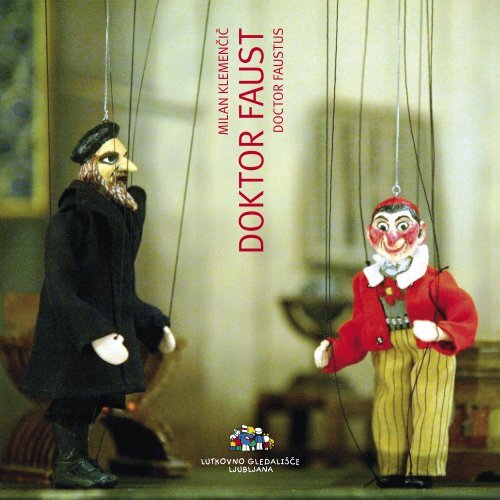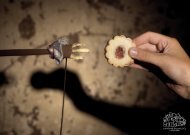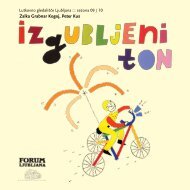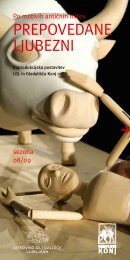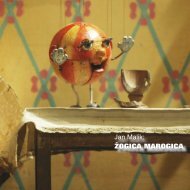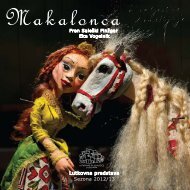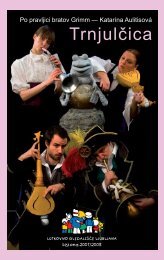Gledališki list - Ljubljana Puppet Theatre
Gledališki list - Ljubljana Puppet Theatre
Gledališki list - Ljubljana Puppet Theatre
Create successful ePaper yourself
Turn your PDF publications into a flip-book with our unique Google optimized e-Paper software.
MILAN KLEMEN»I»<br />
DOKTOR FAUST<br />
DOCTOR FAUSTUS
MILAN KLEMEN»I»<br />
DOKTOR FAUST<br />
PO MOTIVIH IZ 18. STOLETJA<br />
Postavitev z novo zasedbo:<br />
24. oktober 2005<br />
(premiera 12. 11. 1982)<br />
ODER POD ZVEZDAMI LGL<br />
Lutkovno gledaliπËe <strong>Ljubljana</strong>,<br />
sezona 2005/06<br />
Priredba besedila in dramaturgija:<br />
JELENA SITAR, IGOR CVETKO<br />
Reæija:<br />
JELENA SITAR<br />
Lutke in scena:<br />
MILAN KLEMEN»I»<br />
Glasbena oprema:<br />
IGOR CVETKO<br />
Oblikovanje luËi:<br />
MIRAN UDOVI»<br />
Mentorstvo za animacijo:<br />
ALENKA PIRJEVEC<br />
Izdelava in poslikava lutkovnih kopij: JOÆE<br />
LA©I»<br />
Izdelava kostumskih kopij:<br />
MAJA PETERLIN<br />
Izdelava scenskih kopij:<br />
JOÆE LA©I», ALEKSANDRA GRUDEN,<br />
VLADO STJEPI∆<br />
Poslikava scenskih kopij:<br />
VLADO STJEPI∆<br />
Navezava lutk:<br />
MITJA RITMANI»<br />
Nastopajo:<br />
Doktor Faust, profesor v Wittenbergu:<br />
KAREL BRI©NIK<br />
vodita KAREL BRI©NIK,<br />
ALENKA PIRJEVEC<br />
Wagner, njegov oskrbnik:<br />
IZTOK JEREB<br />
GaπperËek:<br />
ALENKA PIRJEVEC<br />
Hektor, vojvoda v Parmi:<br />
IZTOK JEREB<br />
Karon, Ëolnar:<br />
IZTOK JEREB — vodi ALENKA PIRJEVEC<br />
Pluton, gospodar podzemlja:<br />
KAREL BRI©NIK<br />
Mefisto:<br />
IZTOK JEREB<br />
Asmodej:<br />
IRENA ZUBALI» ÆAN<br />
Viclipucli:<br />
ALENKA PIRJEVEC<br />
Lepa Helena:<br />
IZTOK JEREB — vodi ALENKA PIRJEVEC<br />
Dobri duh — glas:<br />
IRENA ZUBALI» ÆAN<br />
Hudobni duh — glas:<br />
IZTOK JEREB<br />
Kozla in straæarja vodi KAREL BRI©NIK<br />
Vodja predstave in luËni mojster:<br />
MIRAN UDOVI»<br />
Vodenje glasbe:<br />
IRENA ZUBALI» ÆAN<br />
ZvoËni efekti:<br />
IZTOK JEREB, MIRAN UDOVI»,<br />
IRENA ZUBALI» ÆAN<br />
DOKTOR FAUST<br />
VELIKA MALA PREDSTAVA<br />
/ IZ BELEÆKE /<br />
Evropsko leto nematerialne kulturne dediπËine je res prava priloænost, da<br />
postane lutkovna predstava Doktor Faust slovenski kulturni spomenik. Za to<br />
ima vse pogoje, tudi tega, da si jo je mogoËe ogledati, kar pomeni, da je na<br />
rednem repertoarju Lutkovnega gledaliπËa <strong>Ljubljana</strong>.<br />
Predstava Doktor Faust je biser slovenske kulture; ena najveËjih zgodb evropskega<br />
Ëloveka je prav v Ljubljani naπla eno najmanjπih prizoriπË, na katerem<br />
se bo odigrala.<br />
Ko gledate predstavo Doktor Faust, gledate dvoje: enkratno umetniπko<br />
kreacijo priËujoËe ekipe in zgodovino in tradicijo slovenskega in evropskega<br />
lutkarstva. Igralci v tej predstavi ne igrajo: oni sluæijo gledaliπËu.<br />
KlemenËiËev Doktor Faust je preæivel æe nekaj generacij in prepriËani smo, da<br />
nismo zadnji, ki soustvarjamo njegovo zgodovino. A za nas je vsaka predstava<br />
Ëarobni trenutek, ki terja od nas najbolje. NatanËno to se dogaja pri tradicionalnem<br />
lutkarstvu — lutke prehajajo iz rok v roke, iz generacije v generacijo. V<br />
priËujoËi predstavi je zdruæena ælahtna tradicija in akademsko znanje. Prav to<br />
pa je bilo tudi naravno okolje, v katerem je leta 1938 Doktor Faust nastal.<br />
Kot del tradicije predstava Doktor Faust drugaËe πteje Ëas. Prav zaradi bivanja<br />
v danem trenutku in ujetosti v brezËasje obenem v njej vzporedno æivijo<br />
vloge æe umrlih, tistih, ki zaËenjajo svojo igralsko pot, in tistih, ki ravnokar<br />
stojijo na odru.<br />
Naπ Faust ima poleg ene rojstne letnice 1938 πe πtiri: 1950, 1982, 2003, 2005.<br />
Vsakokrat znova doæivi premiero. V roke ga namreË vzame druga ekipa. Drug<br />
igralec pomeni drugo duπo — drugo razmiπljanje in drugo Ëutenje, drugo<br />
znanje in drugaËno delo. Faust od vseh izvabi najboljπe: ljubezen in znanje.<br />
Predstava zahteva od izvajalcev popolno zbranost, vsi delajo vse; ni prvakov<br />
in tehnikov: glavni igralec podaja kulise in mojster luËi je v nekem trenutku<br />
glavni igralec. Predstava je urni mehanizem, kjer je pomembna vsaka podaja …<br />
Doktor Faust je prodal svojo duπo. Nima je, zato si jo kar naprej izposoja. Da<br />
lahko æivi za nas. Govorimo o Faustu ali o lutkah? O obojem — in o umetnosti<br />
kot taki.<br />
Jelena Sitar
DOKTOR FAUST<br />
“NihËe ni zadovoljen s svojo usodo: beraË hoËe postati bogataπ, bogataπ ho-<br />
Ëe postati vladar, vladar hoËe podjarmiti svet … Rad bi vse videl, vse vedel …”<br />
Doktor Faust nedvomno predstavlja enega najmarkantnejπih likov evropske<br />
literarne zgodovine. Motiv zgodbe o uËenjaku, ki je v æelji po absolutnem spoznanju<br />
sveta prodal svojo duπo hudiËu, sega v evropski srednji vek. Vendar<br />
pa njegov zametek pomeni æe legenda o Theophilu, ki je priπla v Evropo v 11.<br />
stoletju iz Male Azije in je bila v obliki igre zapisana v Franciji v 13. stoletju.<br />
Temu zapisu so potem sledile razliËne nemπke inaËice. Faust se kot naslovni<br />
junak prviË pojavi v drami Christopherja Marlowa v 16. stoletju. V NemËiji je<br />
v 17. in 18. stoletju postal Doktor Faust ena najbolj priljubljenih iger potujoËih<br />
lutkovnih gledaliπË in se kot del æeleznega repertoarja lutkarjev razπiril po<br />
vsej srednji Evropi. Tako se je z njim sreËal tudi veliki nemπki pesnik Goethe<br />
in ga prelil v svojo znamenito dramsko pesnitev. Pa vendar je Faust veËji del<br />
svojega gledaliπkega æivljenja preæivel na lutkovnih odrih.<br />
Slovenska lutkovna uprizoritev Doktorja Fausta iz leta 1938 v Ljubljani je pomenila<br />
ustvarjalni vrh nestorja slovenskega lutkarstva, slikarja<br />
MILANA KLEMEN»I»A (1875 — 1957),<br />
ki je posegel po leipziπkem zapisu te igre, ga priredil in uprizoril v svojem<br />
gledaliπËu Miniaturne lutke.<br />
Milan KlemenËiË se je nad lutkami navduπil æe v otroπkih letih v Gorici, ob predstavah<br />
italijanskega lutkarja Reccardinija. Kasneje je ob πtudiju slikarstva<br />
v Benetkah, Milanu in Münchnu zahajal v tamkajπnja lutkovna gledaliπËa in<br />
uæival zlasti ob predstavah “papana” Schmida in znamenitega Marionetnega<br />
gledaliπËa münchenskih umetnikov. Po njihovem vzoru se je tudi sam lotil<br />
dela.<br />
22. decembra 1910 je na svojem domu v ©turjah pri AjdovπËini odprl vrata Malega<br />
marionetnega gledaliπËa — z odrsko odprtino 40 x 23 centimetrov in 10<br />
centimetrov “velikimi” lutkami. Premiera igre Mrtvec v rdeËem plaπËu je pomenila<br />
rojstvo slovenskega lutkovnega gledaliπËa, saj so bile na Slovenskem<br />
do tedaj znane le preproste oblike ljudskega lutkarstva. KlemenËiË je sam<br />
zasnoval in izdelal oder, lutke in sceno, sam je reæiral in (ob pomoËi æene) tudi<br />
igral. Do zaËetka prve svetovne vojne je s pomoËjo domaËih pripravil πe pet<br />
premier, dve pa celo leta 1917 v avstrijskem Gradcu, kamor je bil premeπËen<br />
kot rezervni oficir avstrijske vojske.<br />
Po vojni se je z druæino preselil v Ljubljano, kjer ga je na pobudo pisatelja dr.<br />
Ivana Laha ljubljanski gledaliπki konzorcij postavil za vodjo Slovenskega marionetnega<br />
gledaliπËa, prvega (pol)poklicnega lutkovnega gledaliπËa v tedanji<br />
Kraljevini Srbov, Hrvatov in Slovencev. GledaliπËe je delovalo v zgradbi Mestnega<br />
doma od leta 1920 do 1924, ko je moralo kljub navduπenju in podpori<br />
uglednih kulturnih delavcev predvsem zaradi finanËnih teæav zapreti vrata.<br />
K svoji veliki ljubezni, k lutkam, se je razoËarani umetnik spet vrnil πele Ëez<br />
dobrih deset let in 26. aprila 1936 v svoji dnevni sobi v Ljubljani dvignil zastor<br />
gledaliπËa Miniaturne lutke. Poccijevo igro Sovji grad si je naenkrat lahko<br />
ogledalo najveË 30 povabljencev, veËinoma iz ljubljanskih intelektualnih krogov,<br />
za katere so predstave tega malega gledaliπËa (s komaj 12 centimetrov<br />
velikimi lutkami) pomenile pravo kulturno poslastico. To je bilo obdobje umetnikove<br />
zrele ustvarjalnosti, ki je svoj vrhunec dosegla s predstavo Doktor<br />
Faust. Lutkovna ustvarjalnost in likovna umetnost sta se v njej zlili v dovrπeno<br />
scensko podobo.<br />
Izjemnost KlemenËiËevega ustvarjanja, ki je slovensko lutkarstvo tako rekoË<br />
Ëez noË postavilo ob bok najboljπim tedanjim evropskim doseækom, dokazuje<br />
tudi podatek, da ga je leto dni po njegovi smrti mednarodna lutkarska organizacija<br />
UNIMA sprejela za svojega Ëastnega Ëlana.<br />
Umetnikovo zapuπËino je od njegovih dediËev prevzelo Lutkovno gledaliπËe<br />
<strong>Ljubljana</strong>, ki je oæivilo tudi obe predstavi gledaliπËa Miniaturne lutke. Da pa bi<br />
ohranilo krhke izvirnike kot dragocen delËek slovenske kulturne dediπËine, je<br />
izdelalo natanËne kopije Doktorja Fausta, s katerimi ga predstavlja v svojem<br />
rednem repertoarju.<br />
Matjaæ Loboda
BY MILAN KLEMEN»I»<br />
DOCTOR FAUSTUS<br />
AFTER 18TH CENTURY MOTIFS<br />
Recast and produced:<br />
24th October 2005<br />
(premiered on 12th November 1982)<br />
LGL STAGE UNDER THE STARS<br />
Lutkovno GledaliπËe <strong>Ljubljana</strong>,<br />
2005/06 season<br />
Text adaptation and dramaturgy by:<br />
JELENA SITAR, IGOR CVETKO<br />
Directed by:<br />
Jelena Sitar<br />
<strong>Puppet</strong>s and stage design by:<br />
MILAN KLEMEN»I»<br />
Music by:<br />
IGOR CVETKO<br />
Lights by:<br />
MIRAN UDOVI»<br />
Animation directions by:<br />
ALENKA PIRJEVEC<br />
<strong>Puppet</strong> copies made and painted by:<br />
JOÆE LA©I»<br />
Costume copies made by:<br />
MAJA PETERLIN<br />
Stage set copies made by:<br />
JOÆE LA©I», ALEKSANDRA GRUDEN,<br />
VLADO STJEPI»<br />
Stage set copies painted by:<br />
VLADO STJEPI»<br />
<strong>Puppet</strong>s strung by:<br />
MITJA RITMANI»<br />
Cast:<br />
Doctor Faustus, professor in Wittenberg:<br />
KAREL BRI©NIK — animated by<br />
KAREL BRI©NIK, ALENKA PIRJEVEC<br />
Wagner, his servant:<br />
IZTOK JEREB<br />
Kasperle:<br />
ALENKA PIRJEVEC<br />
Hector, Duke of Parma:<br />
IZTOK JEREB<br />
Caron, the boatman:<br />
IZTOK JEREB — animated by<br />
ALENKA PIRJEVEC<br />
Pluto, Lord of the Underworld:<br />
KAREL BRI©NIK<br />
Pephisto:<br />
IZTOK JEREB<br />
Asmodeus:<br />
IRENA ZUBALI» ÆAN<br />
Vitzliputzli:<br />
ALENKA PIRJEVEC<br />
Helen of Troy:<br />
IZTOK JEREB — animated by<br />
ALENKA PIRJEVEC<br />
Good angel — voice:<br />
IRENA ZUBALI» ÆAN<br />
Evil angel — voice:<br />
IZTOK JEREB<br />
The goat and the sentry are animated by<br />
KAREL BRI©NIK<br />
Production management and lighting by:<br />
MIRAN UDOVI»<br />
Music management by:<br />
IRENA ZUBALI» ÆAN<br />
Sound effects by:<br />
IZTOK JEREB, MIRAN UDOVI»,<br />
IRENA ZUBALI» ÆAN
DOCTOR FAUSTUS<br />
“Nobody is satisfied with their destiny: A beggar wants to become rich, a rich<br />
man wants to become a king, a king wants to subdue the world … I’d like to<br />
see all, know all …”<br />
Doctor Faustus is undoubtedly one of the most prominent characters in European<br />
literary history. The motif of the story about a scholar who sells his soul<br />
to the devil in his desire for absolute knowledge of the world can be tracked<br />
down to the European Middle Ages. Its origin however can be found in the<br />
legend of Theophilus brought to Europe from Asia Minor in the 11th century,<br />
and written down as a play in 13th century France. Different German variants<br />
followed. Faustus as the title hero first appears in Christopher Marlowe’s drama<br />
from the 16th century. Doctor Faust became one of the most popular plays<br />
performed by travelling puppet theatre companies in 17th and 18th century<br />
Germany, spreading as part of puppeteers’ standard repertory throughout<br />
Central Europe. The great German poet Goethe saw a play and transformed it<br />
into his famous epic. Nevertheless, Faustus has spent the most of his theatre<br />
life on the puppet theatre stage.<br />
The Slovenian Doctor Faustus puppet production of 1938 in <strong>Ljubljana</strong> was the<br />
creative pinnacle of Slovenian puppetry pioneer, painter<br />
MILAN KLEMEN»I» (1875 — 1957),<br />
who used the Leipzig text of the play, adapted and produced it at his Little<br />
Marionette <strong>Theatre</strong>.<br />
Milan KlemenËiË was fascinated by puppets as a child in Gorizia watching<br />
shows performed by Italian puppeteer Reccardini. Studying art in Venice,<br />
Milan and Munich, he visited puppet theatres in those cities, enjoying above<br />
all productions by “Papa” Schmid and the famous Munich artists’ Marionette<br />
<strong>Theatre</strong>. Following their example he set to work on his own.<br />
On 22nd December 1910, he opened the door of Little Marionette <strong>Theatre</strong> at<br />
his home in ©turje by AjdovπËina — with a stage opening measuring 40 cm by<br />
23 cm, and 10 cm “tall” puppets. The opening of The Dead Man In The Red Coat<br />
marked the birth of Slovenian puppet theatre, since only rudimentary forms<br />
of folk puppetry had been known in Slovenia until then. KlemenËiË designed<br />
and made his own stage, puppets and sets, directed and performed (aided by<br />
his wife). By the beginning of World War 1 he and his family produced five more<br />
plays, premiering two in Graz, Austria, where he was stationed as a reserve<br />
officer of the Austrian army.<br />
After the war, he and his family moved to <strong>Ljubljana</strong> where the <strong>Ljubljana</strong><br />
<strong>Theatre</strong> Consortium, on writer Ivan Lah’s initiative, had appointed him head<br />
of Slovenian Marionette <strong>Theatre</strong>, the first (semi)professional puppet theatre<br />
in the former Kingdom of Serbs, Croats and Slovenes. The theatre operated<br />
in the building of Town Centre from 1920 to 1924 when it was forced to close<br />
down, primarily due to financial problems, in spite of all the enthusiasm and<br />
support of prominent artists.<br />
The disillusioned artist returned to his great love, the puppets, only a good<br />
ten years later, and opened the curtain of the Miniature <strong>Puppet</strong>s theatre in<br />
his living room on 26th April 1936. The production of Pocci’s The Owl’s Castle<br />
would seat 30 invited guests per show, mostly <strong>Ljubljana</strong> intellectuals to<br />
whom shows of this small theatre (with just 12 cm puppets) were true cultural<br />
delicacies. The artist’s creativity had reached maturity by that period, and<br />
culminated in Doctor Faustus. <strong>Puppet</strong>ry and fine art merged in it into a perfect<br />
stage image.<br />
A proof of excellence of KlemenËiË’s creative work, which put Slovenian puppetry<br />
among of the highest European achievements of the time overnight, so<br />
to speak, is the fact that the international puppeteers’ organisation, UNIMA<br />
accepted him posthumously as honorary member a year after his death.<br />
The artist’s legacy, taken over from his heirs, is in the custody of Lutkovno<br />
GledaliπËe <strong>Ljubljana</strong> which has revived the two shows of the Miniature <strong>Puppet</strong>s<br />
theatre. In order to preserve the fragile originals as a precious piece of<br />
Slovenian art history, we have made exact copies of Doctor Faustus puppets<br />
using them in our regular programme.<br />
Matjaæ Loboda
DOCTOR FAUSTUS<br />
SUMMARY<br />
Prologue — UNDERWORLD<br />
Boatman Caron complains to his master, Pluto, the lord of the underworld,<br />
that his lazy devils bring too few sinners to him. So Pluto summons the idlers<br />
and sends them to Earth at once — with a special instruction to bring him an<br />
important person whose soul is worth a thousand others.<br />
Act I — FAUSTUS’ STUDY<br />
Dr Faustus, the famous professor and scholar is not satisfied with himself.<br />
He would like to know all secrets of the world. The evil angel appears offering<br />
help. The good angel warns him …<br />
The cunning traveller, Kasperle, drops by at the house looking for work. On recommendation<br />
from his servant, Wagner, Faustus takes Kasperle on as help.<br />
Act II — FOREST<br />
At midnight, Faustus is in the woods under an old oak tree calling for devils<br />
in order to pick a servant among them. He chooses Mephisto who is willing to<br />
take the job — if only his hellish master Pluto agrees.<br />
Faustus leaves and Kasperle appears discovering a vicious circle under the<br />
oak tree. He steps into the circle … as evil devils emerge who want to tear<br />
him apart. But Kasperle speaks out a few magic words he found in Faustus’<br />
books, and has fun with the devils.<br />
Act III — FAUSTUS’ LABORATORY<br />
Faustus waits for Mephisto. The devil appears taking on human form. He will<br />
serve him, if Faustus promises his soul to him. The good angel warns Faustus,<br />
but the scholar pays no attention to him, signing the contract in his own blood.<br />
Kasperle appears, and Mephisto would like to recruit him, too, but Kasperle<br />
is far too clever to fall for it. Mephisto sends him after Faustus to Parma on a<br />
flying goat to attend duke Hector’s marriage festivities.<br />
Act IV — CASTLE PARK IN PARMA<br />
Hector, Duke of Parma, takes a walk in his park, as Kasperle drops down in<br />
front of him (off the flying goat). Although he should not disclose who he is
and whom he serves, the talkative trickster lets it slip, and the duke discovers<br />
what a famous guest he hosts. He calls for Faustus immediately asking him to<br />
perform some of his magic. Kasperle looses his job again. Demon Asmodeus<br />
promises him a night watchman’s job, if he gave him his soul. Kasperle agrees<br />
— he is a puppet, and has got no soul anyway.<br />
Faustus finds no peace of mind, and has become tired of all. Mephisto brings<br />
him Helen of Troy. Faustus is enchanted. What the devil cannot do a woman can!<br />
Act V — A STREET IN WITTENBERG<br />
Faustus is disappointed with his life, and the contract with Mephisto is coming<br />
into force. The sly devil has added nights to his days of service, tricking<br />
him in this way.<br />
Night watchman Kasperle roams the streets singing his songs. Asmodeus appears<br />
before him claiming Kasperle’s soul. But the resolute trickster threatens<br />
him that he will burn his whiskers — and the frightened demon runs away.<br />
A figure walks toward Kasperle, and he recognises his former master, Faustus<br />
who owes him two salaries. Hoping that the devil would grab the wrong person,<br />
Faustus offers Kasperle his coat as payment. But Kasperle is no fool.<br />
There is no more hope for Faustus. The voice of the evil master echoes, and<br />
the door to hell opens …<br />
Matjaæ Loboda<br />
LUTKOVNO GLEDALI©»E<br />
LJUBLJANA<br />
was founded in 1948. It found its initial inspiration in various traditions which<br />
influenced Slovenian puppetry from its beginnings in the second decade of<br />
the 20th century (Milan KlemenËiË’s theatre), between the two world wars,<br />
(43 string puppet stages at Sokol gym societies; Pavliha’s stage — hand puppet<br />
theatre with the set character, jokester Pavliha, Slovenian variant of Pulcinella,<br />
Punch, Kasperle, Petrushka, etc.) to the end of World War Two (Partisan<br />
<strong>Puppet</strong> <strong>Theatre</strong>). The young theatre was caught in a labyrinth of aesthetics.<br />
Above all thanks to art director, director, actor and writer Joæe Pengov, the<br />
founder of modern Slovenian puppetry, it soon found its own expression and<br />
achieved an enviable artistic level, which it has confirmed at festivals of the<br />
international puppetry organisation, UNIMA (Bucharest 1958, Bochum 1960,<br />
Warsaw 1962), as well as by filming for German television (Pinocchio 1961, Little<br />
Witch 1968). After Pengov’s death and the switch of generations, looking<br />
for new directions was inevitable, and they brought to the theatre a number of<br />
new, prominent Slovenian writers, directors, artists and musicians, winners of<br />
the most prestigious art awards — including awards for their contributions to<br />
productions of Lutkovno GledaliπËe <strong>Ljubljana</strong>.<br />
The theatre achieved full recognition in the fourth decade of its operation<br />
when it moved to a new venue (1984) which offered new performing possibilities.<br />
The repertory broadened from soloist miniatures to spectacular<br />
productions using the widest possible array of puppeteering techniques. The<br />
era was marked by a renewed, intensified engagement in the international<br />
arena. Lutkovno GledaliπËe <strong>Ljubljana</strong> has so far made around 130 tours of 31<br />
countries on all continents, and has visited over 100 cities achieving wide<br />
acclaim and receiving numerous festival awards. It has succeeded in breaking<br />
the ice at home, taking part in theatre (non-puppetry) festivals — winning<br />
awards there, too.<br />
Recently, generations have switched again both in the theatre management<br />
and personnel. The new creative minds and genres broadened yet again the<br />
scope of programme. The twelve members of the company (with outside<br />
collaborators) put on stage eight premieres a year and give around 460 shows<br />
locally, touring Slovenia and other countries. The most attention is paid to the<br />
youngest audiences, however the theatre produces demanding shows for yo-
ung people and adults as well. Through productions, such as Doctor Faustus,<br />
and occasional exhibitions we wish to maintain a bridge between tradition<br />
and the present.<br />
In 1992, Lutkovno GledaliπËe <strong>Ljubljana</strong> co-organised the UNIMA ’92 congress<br />
and festival, assuming the organisation of LUTKE ’95 festival three years later,<br />
which has become a regular, widely international biennial event.
Gledaliπki <strong>list</strong>, sezona 2005/06<br />
Izdalo: Lutkovno gledaliπËe <strong>Ljubljana</strong><br />
Za izdajatelja: Marjan GabrijelËiË<br />
Uredil: Matjaæ Loboda<br />
Lektorirala: Tatjana StaniË<br />
Prevedel: Andrej Hiti Oæinger<br />
Oblikovala: ©pela Goltes<br />
Fotografije: arhiv LGL<br />
GrafiËna priprava in tisk: Fotolito Dolenc<br />
Naklada: 2000 izvodov<br />
obËine <strong>Ljubljana</strong> — Oddelka za kulturo in raziskovalno dejavnost<br />
omogoËajo realizacijo programov.<br />
nam poleg Ministrstva za kulturo Republike Slovenije in Mestne


